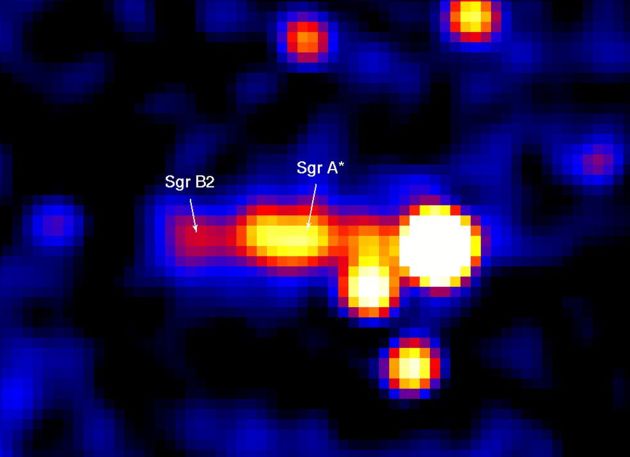Recent Outburst: Milky Way's Black Hole Could Erupt Again

An outburst of energy emanated from the black hole at the center of the Milky Way Galaxy just 350 years ago Earth-time, astronomers announced Wednesday.
Though the eruption was seen only indirectly, a similar one could occur in the future and would be detectable by space-orbiting telescopes. The finding confirms suspicions that the relatively calm black hole is not always quiescent.
Most large galaxies contain a central black hole. When gas spirals in toward such an immense gravity sinkhole, a portion of the gas is consumed while some is spat back out. Along the way, the material is superheated and gives off X-rays and other radiation in a highly turbulent region. This causes the cores of very active galaxies to shine brilliantly.
The Milky Way, however, seems to be on a diet. Other than some intense radio emissions, it's central black hole, called Sgr A* (pronounced 'Sagittarius A star') emits surprisingly little.
Tricky detection
The new study, using data from the European Space Agency's orbiting Integral observatory, found that compared to today, the black hole released nearly a million times more energy during the outburst, which lasted about a decade.
The radiation storm moved away from the black hole at the speed of light, but technology was not able to witness the event at the time. The eruption was detected now because it is currently interacting with a cloud of hydrogen gas that's 350 light-years from the black hole. A light-year is the distance light travels in a year, about 6 trillion miles (10 trillion kilometers).
Get the Space.com Newsletter
Breaking space news, the latest updates on rocket launches, skywatching events and more!
Figuring out where the radiation came from is a bit like spotting oversized waves on a sunny beach and tracing their origin to a hurricane way out in the Atlantic, measurably away in time and space.
X-rays and gamma rays spat out from the black hole are now "washing ashore" on the gas cloud, which is known as Sgr B2. In a convenient cosmic twist, the cloud absorbs and re-emits the radiation in a characteristic manner, sending some of it right at us.
"About 350 years ago, the region around Sgr A* was literally swamped in a tide of gamma rays," said study leader Mikhail Revnivtsev of the Space Research Institute in Moscow and the Max Planck Institute for Astrophysics in Germany. "We are now seeing an echo from a sort of natural mirror near the galactic center -- the giant cloud Sgr B2 simply reflects gamma rays emitted by Sgr A* in the past."
More to come
The glowing of the gas cloud was first noted by X-ray astronomers. The analysis of Integral's gamma-ray data allowed Revnivtsev's team to reconstruct the relationship of the event to the previous eruption of the black hole.
The whole scene is about 26,000 light-years from Earth. In reality, the black hole's outburst occurred some 26,350 years ago. But it has taken the black hole's radiation 26,350 years to hit the gas cloud, be redirected, and reach Earth.
The researchers expect the Milky Way's black hole will become bright again "in the foreseeable future." If such an eruption occurs, it will be the first notable change in the black hole since X-ray and gamma-ray telescopes were in position above Earth's atmosphere to record the activity.
- About the Black Hole
- Survival Tips for Black Hole Travelers
Join our Space Forums to keep talking space on the latest missions, night sky and more! And if you have a news tip, correction or comment, let us know at: community@space.com.

Rob has been producing internet content since the mid-1990s. He was a writer, editor and Director of Site Operations at Space.com starting in 1999. He served as Managing Editor of LiveScience since its launch in 2004. He then oversaw news operations for the Space.com's then-parent company TechMediaNetwork's growing suite of technology, science and business news sites. Prior to joining the company, Rob was an editor at The Star-Ledger in New Jersey. He has a journalism degree from Humboldt State University in California, is an author and also writes for Medium.










